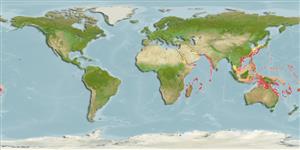Common names from other countries
>
Eupercaria/misc (Various families in series Eupercaria) >
Labridae (Wrasses) > Bodianinae
Etymology: Bodianus: Bodianus after Bodiano or Pudiano, from the Portuguese pudor, meaning modesty (Jordan & Evermann, 1896).; leucosticticus: The subgenus Peneverreo come from the Latin pene for near and verres for boar, in reference to the close relationships and similarity of colour patterns between members of this subgenus and those of the subgenus Verreo (Ref. 75973).
More on author: Bennett.
Environment: milieu / climate zone / depth range / distribution range
Ecologia
marino associati a barriera corallina; distribuzione batimetrica 50 - 75 m (Ref. 90102). Tropical
Indo-West Pacific: Somalia, Mozambique, Natal (South Africa), Mauritius, Réunion, and southern Japan. Likely at Seychelles (Ref. 1623) if Lepidaplois luteopunctatus is a synonym of Bodianus leucosticticus.
Size / Peso / Age
Maturity: Lm ? range ? - ? cm
Max length : 24.2 cm SL maschio/sesso non determinato; (Ref. 13277)
Short description
Chiavi di identificazione | Morfologia | Morfometria
Spine dorsali (totale) : 12; Raggi dorsali molli (totale) : 10; Spine anali: 3; Raggi anali molli: 12. Adults reddish to purplish brown on head, body dull yellow; longitudinal row of 3 pale yellow spots along back; small black spot centered at base of caudal fin; 2 black spots on soft anal fin; large black spot on pelvic fins; blackish spot anteriorly on dorsal fin (Ref. 4392). Juveniles reddish brown with rows of white blotches and small spots; black spots on fins (Ref. 4392).
Adults are usually found at moderate depths (50 m). Oviparous, distinct pairing during breeding (Ref. 205).
Life cycle and mating behavior
Maturities | Riproduzione | Spawnings | Egg(s) | Fecundities | Larve
Oviparous, distinct pairing during breeding (Ref. 205).
Randall, J.E., 1986. Labridae. p. 683-706. In M.M. Smith and P.C. Heemstra (eds.) Smiths' sea fishes. Springer-Verlag, Berlin. (Ref. 4392)
IUCN Red List Status (Ref. 130435)
CITES (Ref. 128078)
Not Evaluated
Threat to humans
Harmless
Human uses
Pesca: scarso interesse commerciale
Strumenti
Special reports
Download XML
Fonti Internet
Estimates based on models
Preferred temperature (Ref.
115969): 23.3 - 28.1, mean 26.9 (based on 81 cells).
Phylogenetic diversity index (Ref.
82804): PD
50 = 0.5000 [Uniqueness, from 0.5 = low to 2.0 = high].
Bayesian length-weight: a=0.01202 (0.00551 - 0.02625), b=3.05 (2.87 - 3.23), in cm Total Length, based on LWR estimates for this Genus-body shape (Ref.
93245).
Trophic level (Ref.
69278): 3.5 ±0.5 se; based on size and trophs of closest relatives
Resilienza (Ref.
120179): Medio, tempo minimo di raddoppiamento della popolazione 1.4 - 4.4 anni (Preliminary K or Fecundity.).
Fishing Vulnerability (Ref.
59153): Low vulnerability (20 of 100).
